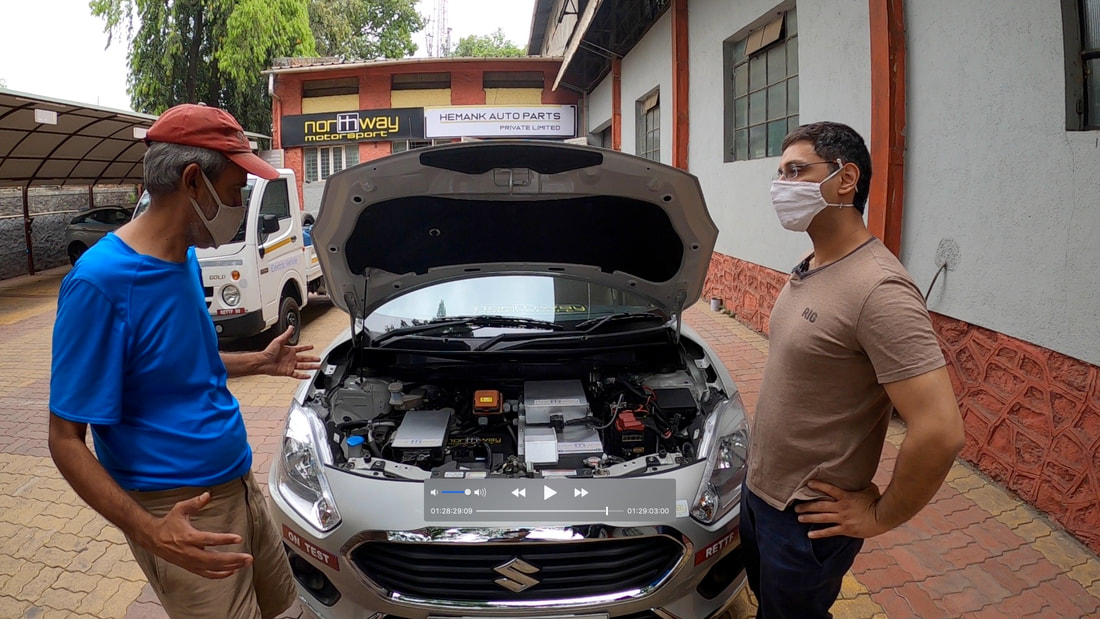The Nexon EV electric car has proved that familiarity sells in India. The magic sauce is to take an existing best seller and electrify it. So Hemank chose Maruti Suzuki's Swift Dzire. The Dzire has two distinct advantages over the Nexon - it's lighter and it's got better aerodynamics. And both these characteristics also help deliver on range. Hemank claims that the Dzire EV that he has come up with has a power consumption of about 85 Wh/km. With a 25 kWh battery this would mean a range of 25,000/85, approximately 300 km. The Wh/km does not include AC, so realistic range can go down to about 250 km. To put this in a Nexon perspective, the average Nexon gobbles up about 200 Wh/km, and with a 30 kWh battery - that means a range of 150 km.
For a kitted car to handle well, you also need to understand suspensions. A car's springs and shockers are designed for a certain weight distribution. If you change the weight or it's distribution, then the handling will change. Imagine a Nano EV project where the motor and battery gets fitted on the front wheel. (The Nano is a rear engine, rear wheel drive.) The smaller front wheels and the relatively less stiff front suspension will now be in trouble. So you have to ensure that your converted car weight matches that of the original. (Government norms for conversion allow you a 10% deviation.) And you also need to ensure that the weight distribution between front and rear remains as close to the original as possible.
The existing Swift Dzire vehicle electronics is made to believe that it's actually the engine that is running. This is done by some clever engine mapping. You look at sensor output at different torque rpm combinations and modify the EV sensor outputs to match ICE outputs. This means that you don’t need to rebuild the Car OS. On the odometer, the motor rpm is displayed in the same space as the engine rpm. (System on is indicated by 1000 rpm.) The SOC has been calibrated to be shown on the fuel gauge.
The radiator is put to good use for battery cooling. There is also a chiller for the coolant after the radiator. I don't think that ver 1 has got battery heating - but it should not be too difficult a feature to add. Some loss of precision is there. Hemank plans to add a bluetooth fed dashboard mounted gizmo to show stuff like actual SoC, regen and battery health. There is no change to the chassis. Which means that you can get the kitting done by a good local mechanic.
There are some advantages of retaining a mechanical gear box. Range is the most important one. The motor runs between speeds of 500 to 4000 rpm. So to remain in the range sweet spot of speed, you use the 5th gear on the highway. Clutch is there. With a low coefficient of drag, you can expect a lower Wh/km vis-a-vis the Nexon at highway speeds. Hemank uses a custom made motor, with the rotor on the outside. This helps deliver better torque, as the electromagnetic forces are away from the shaft. Motor is rated at 60 kW peak and 30 kW continuous power. Top speed is a humongous 160 kmph. Thanks to the high starting torque of motors, you can run this car as an automatic. You can start in the third gear and stay there for all your city driving.
DC Charging and regular CCS charger is standard. The charger is located in the fuel tank lid location. Would have liked a storage area for the cable which can be accessed easily. It will take an Apple kind of company to actually realize that some thinking has to go in to making the charging experience more pleasurable. The cable is not really featherweight. And it tends to get twisted into Gordian knots in storage. Some thinking is required. I like the Chetak's solution of putting it in a special slot in the front dicky. It's a ground up scooter - and so it's easy to execute such comforts. Did not get a good look at the underside, but some work required there. Especially in the exhaust pipe area. We did hit a speed breaker in our small trip. Regen is there. But regen fine tuning is an art - and would only comment on that once I get to actually drive the car.
Maruti should adopt the Northway model - and sell it as a sub brand like the way AMG does with Mercedes. AMG stands for performance - and so does Northway. Speaking for myself, I would have preferred that a kit be developed for the Baleno. It\s a more contemporary car with great looks and finishes. Did you know that Suzuki buys Balenos from India for export to Japan!
EV kits are still not popular. One reason could be reliability - warranty void etc. The other could be capital cost. But EV kits make for great commercial and economic sense. They give a clean second life to vehicles. Government should mandate electrification of mechanically sound cars after the 15 year life gets over. The acid test for electrification would be with fleet owners. How much are they ready to spend. If the kit is priced around 4 lakh, Northway has a killer. but looks very likely that the figure will be closer to 6 lakh. Fingers crossed!


